La planification des opérations pour contenir une marée noire (2/2) (en anglais)
Contigency Planning in Oil Spill Response (2/2)

Strategy
Strategies in oil spill response usually cover eight main areas:
1 - Introduction
In the introduction, the authority or lead agency responsible for the formulation and implementation of the plan and an explanation of the statutory requirements, if any, should be defined. The geographical coverage of the plan should be outlined and reference made to interfaces with other plans.
2 - Risk assessment
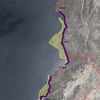
Amenity areas, ecologically sensitive areas, sea water intakes, fisheries, mariculture, seabirds and marine mammals and other resources likely to be threatened by an oil spill should be identified. Since it will not be possible to give equal protection to all sensitive resources, priorities need to be determined. Account should be taken of the practical problems as well as the relative economic and environmental values of each resource and their sensitivity to oil pollution. Seasonal variations e.g. of beaches and breeding areas should be noted. Information on the location and sensitivity of resources and priorities for protection is frequently provided in the form of maps annexed to the contingency plan.
3 - Resources at risk and priorities for protection

Amenity areas, ecologically sensitive areas, sea water intakes, fisheries, mariculture, seabirds and marine mammals and other resources likely to be threatened by an oil spill should be identified. Since it will not be possible to give equal protection to all sensitive resources, priorities need to be determined. Account should be taken of the practical problems as well as the relative economic and environmental values of each resource and their sensitivity to oil pollution. Seasonal variations e.g. of beaches and breeding areas should be noted. Information on the location and sensitivity of resources and priorities for protection is frequently provided in the form of maps annexed to the contingency plan.
4 - Response strategies
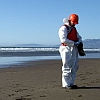
Clean-up strategies should be determined in relation to the perceived risk and agreed response priorities. Account should be taken of the limitations of spill control techniques and the most appropriate equipment chosen for the anticipated weather conditions and oil types. Shoreline clean-up strategies should be prepared for the types of coastline likely to be encountered. Predetermined temporary waste storage sites and disposal routes should be detailed. Maps detailing strategies and restrictions, access points and waste sites should be annexed.
5 - Organisation and management
The outline of the response organisation and the responsibilities of those likely to be involved should be detailed. The size of the response organisation will depend on the area covered by the plan, the severity of the threat and the sensitivity of any threatened resources. Relevant government departments, advisors and experts should be annexed.
6 - Equipment, supplies services and human power
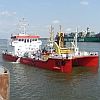
The siting of response equipment and the procedures for mobilisation should be determined. An inventory of available equipment should be annexed. Provision for food clothing, shelter, medical facilities and other logistics support should be also detailed. The availability of back-up support should be recorded, both nationally and internationally. In the latter case, provision should be made for customs and immigration procedures as well as financial arrangements. The personnel required to respond to a spill should be estimated. Additional human power may be required in the case of large spills. Contractors and other sources of human power should be annexed.
7 - Communications and control
The establishment of a fully equipped communications centre should be predetermined to ensure that the correct information is passed to the correct people. The centre should act as a central channel for all information. Where clean-up operations are conducted over extended distances, portable communications centres should be located close to the scene of operations. Supplies of charts, maps, reports, manuals etc. should be provided for. Accurate recording of all actions and maintenance of appropriate documentation related to the assignment of personnel, equipment and materials as well as expenditure is vital for future reference and the submission of claims for compensation.
8 - Training, exercises and updating procedures
Training programs should be developed for all levels of response personnel. Exercises should be held at regular intervals to ensure the plan functions correctly and to familiarise all participants with its contents. Detailed equipment should be mobilised and deployed to test its actual availability and performance. An oil spill provides the best opportunity for improving a plan. Events should be reviewed soon after clean-up has been completed and the plan revised on the basis of lessons learnt.
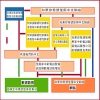
Operational plan
The operational procedure can be divided into six main parts, generally following the chronological order of occurrence during a spill:
1 - Notification
The information required to allow an accurate evaluation of an incident should be detailed i.e. date, time, position, source, cause, amount and type of oil, slick size etc. and the procedure for the evaluation of the seriousness of the incident should be given. A programme for alerting response personnel and the relevant authorities should be included.
2 - Evaluation
Methods for trajectory modelling, procedures for aerial and terrestrial surveillance, for the identification of threatened resources and for notifying pre-identified parties likely to be affected should be included.
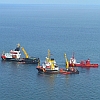
3 - Response
The plan should allow the consideration of various response options according to the situation. Procedures for placing personnel and equipment on standby prior to mobilisation should be included. Procedures should be included for establishing a dedicated response centre, for mobilising and deploying the necessary equipment and manpower, organising logistic support, continuing with any aerial surveillance and considering any disposal options. In addition, provision should be made for locating a command post close to the site of the incident. Procedures for opening channels of communication should be detailed.
4 - Clean-up
Guidelines for the level of clean-up required for each location should be given together with procedures for standing down equipment. Guidelines for the restoration of temporary storage sites should be outlined.
5 - Communication
Regular communication between all parties is vital to ensure an effective response.
6 - Termination
Listings of information that will be required to facilitate an efficient and effective response should be included as a series of annexes.
- Contact directory of response personnel - out of office contact details should be included where appropriate.
- Contact directory of third parties - parties likely to have an interest in an incident e.g. police, media, parties of likely impact and other authorities.
- Primary response equipment - government, private contractor and oil industry equipment.
- Auxiliary response equipment - sources of workboats, tugs, helicopters, aircraft, barges, vacuum trucks, tractors, protective clothing, hand tools, radios etc.
- Logistics suppliers - suppliers of catering, housing, transport, sanitation, laundry etc.
- Human power sources - contractors, local authorities, military, fire brigades, volunteer organisations and other sources.
- Experts and advisors - personnel with detailed knowledge of oil pollution; of the local coastal environment, particularly of flora and fauna; of safety; and of other areas.
- Maps of sensitive areas - showing detailed information on the location of amenity and ecologically sensitive areas; sea water intakes; fisheries; mariculture; seabirds and marine mammals; and other resources likely to be threatened. Seasonal sensitivity should be highlighted.
- Maps of the coastal region - showing priorities for protection; illustrating strategies and restrictions; access points; waste sites; etc.
- Oil types likely to be encountered - detailing their properties; persistence; likely fate and effects; suitable response techniques; etc.
Content: ITOPF
